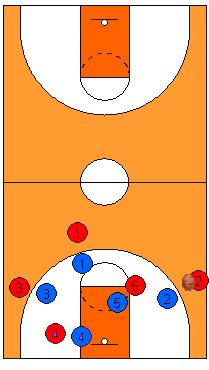
Press Offense Quite often, a good fast breaking team will not have to worry about being pressed until the very end of a game. Because opponents fear the running game, they will not use a press and instead, emphasize getting back to stop the break. A good press offense will be needed eventually though, provided your team is in the lead at the end. Using the deep pass from #4 to #2 or #4 to #5 is a great way to make pressing opponents pay a price. Before they have set up their press, your team can score a lay-up in a couple of seconds. Even a quick inlet and sideline pitch can catch the full court press unprepared at times. (#1 to #2) If #1 is not able to pass up the sideline immediately verses a press, a more conventional attack is required. #5 should read that #1 needs help and he must come back to the middle of the court looking for a pass. #4, as always, stays behind the ball, but widens out a little, away from #1, so he may take a back-pass and reverse the ball to the other sideline (#3). The press offense takes on the shape of a 2-1-2 setup and spreads the court enough to find gaps in the full court defense. When the ball is reversed to #4, he also has the option of passing to #5 in the center of the court if #3 is covered. #5 must meet any ball thrown his way aggressively and then immediately face his basket upon receiving a pass. #5 then looks to the sidelines for either #2 or #3, either of whom may be open as they head to the basket. The 2-1-2 standard attack works well against almost all zone presses. A man to man press calls for a slight adjustment though. If the ball cannot be pitched ahead right away by #1, he should then signal his teammates to clear out so he can bring the ball up alone. As his teammates clear, they must watch their #1 to make sure he does not get trapped in this situation. If a trap occurs, the teammate whose defender has left to do the trapping will be open for a pass. This player should come back to the ball, catch any pass thrown to him aggressively, turn and face his basket, and look ahead for open teammates. End of game situations call for special out of bounds plays designed to make your opponents pay if they pressure you. Lining up with all players in a pack, a line, or other such setup may allow one of your players to release deep suddenly and get an easy basket. Finding ways to get the ball in bounded to your best free throw shooter may also be a “special situation” worth covering in practice. A team that runs the whole game usually can handle running late in a tight game too. They know how to score quickly and easily, so it is no time for them to get conservative. Make your press offense as similar to your fast break as possible, and the players will react confidently and successfully. |
 |